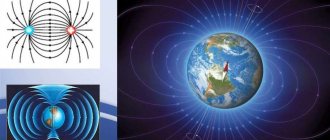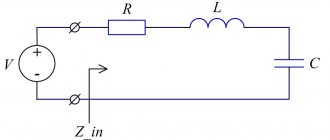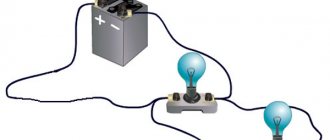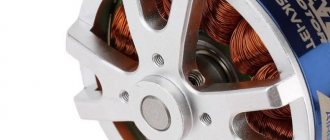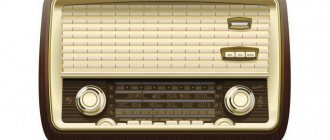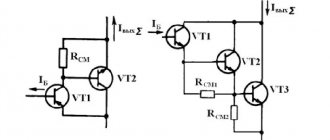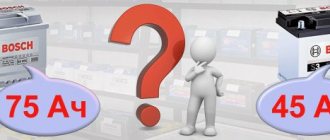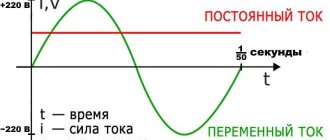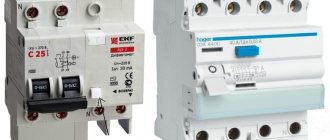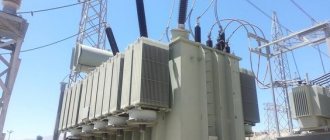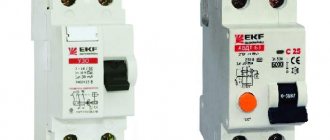A Neodymium magnet
(also known as
NdFeB
,
NIB
, or
Neo
magnet) is the most widely used[1] type of rare earth magnet. It is a permanent magnet made from an alloy of neodymium, iron, and boron to form a Nd2Fe14B quadrangular crystal structure.[2] Independently developed in 1984 by General Motors and Sumitomo Special Metals,[3][4][5] neodymium magnets are the most powerful permanent magnets available on the market.[2][6] Due to different manufacturing processes, they are divided into two subcategories: sintered NdFeB magnets and bonded NdFeB magnets.[7][8] They have replaced other types of magnets in many applications in modern products requiring strong permanent magnets, such as electric motors in cordless tools, hard drives, and magnetic fasteners.
Story
General Motors (GM) and Sumitomo Special Metals independently discovered Nd2Fe14B almost simultaneously in 1984.[3] The research was initially prompted by the high cost of raw materials. SmCo permanent magnets which were developed earlier. GM focused on developing melt-spun nanocrystalline neodymium 2Fe14B, while Sumitomo developed sintered Nd2Fe14B magnets. GM commercialized its inventions isotropic neo powder, bonded neo magnets, and related manufacturing processes, founding Magnequench in 1986 (Magnequench has since become part of Neo Materials Technology, Inc., which later merged with Molicorp). The company supplied melt-formed neodymium 2Fe14 Powder B to magnet manufacturers. The Sumitomo facility became part of Hitachi Corporation, and produced but also licensed to other companies the production of sintered neodymium 2Fe14 magnets. Hitachi holds over 600 patents for neodymium magnets.[9]
Chinese manufacturers have become the dominant force in neodymium magnet production due to their control of much of the world's rare earth supply.[10]
The US Department of Energy identified the need to find substitutes for rare earth metals in permanent magnet technology and funded such research. The Advanced Research Projects Agency - Energy sponsored the Rare Earth Alternatives in Critical Technologies (REACT) program to develop alternative materials. In 2011, ARPA-E awarded $31.6 million to fund rare earth replacement projects.[11] Because of its role in permanent magnets used for wind turbines, it has been argued that neodymium will become one of the major targets of geopolitical competition in the world's renewable energy sector. But this view has been criticized for not recognizing that most wind turbines do not use permanent magnets and for underestimating the power of economic incentives to expand production.[12]
Neodymium magnet – application in medicine
Only a trained specialist knows how to use a neodymium magnet correctly. This alloy is used in many areas of industry, mechanical engineering, agriculture and medicine. Neodymium magnets are an integral part of many devices for diagnosing diseases: tomographs, X-ray machines and other important devices.
Among other things, magnets are used for:
- manufacturing of insoles;
- in physiotherapy (by applying to painful points);
- production of magnetic belts.
Magnets for treating joints at home can be used by applying an alloy to sore joints. But self-medication is dangerous, so it would be more advisable to first consult with your doctor and rule out diseases for which the use of magnets is prohibited.
Magnetic therapy is aimed at:
- reduction of pain syndrome;
- relieving inflammation;
- improving the patient's general health.
Composition
Neodymium is a metal that is ferromagnetic (more specifically it shows antiferromagnetic properties), that is, like iron, it can be magnetized to become a magnet, but its Curie temperature (the temperature above which its ferromagnetism disappears) is 19 K (-254. 2 °C; -425.5 °F), so in its pure form its magnetism only appears at extremely low temperatures.[13] However, compounds of neodymium with transition metals such as iron can have a Curie temperature much higher than room temperature, and they are used to make neodymium magnets.
The strength of neodymium magnets is the result of several factors. Most importantly, the tetragonal Nd2Fe14 crystal structure B has exceptionally high uniaxial magnetocrystalline anisotropy ( HR
A ≈ 7 - magnetic field strength H in units of A / m depending on the magnetic moment in A m2).[14][3] This means that a crystal material is preferentially magnetized along a certain crystal axis but is very difficult to magnetize in other directions. Like other magnets, a neodymium alloy magnet is composed of microcrystalline grains that are aligned in a powerful magnetic field during manufacturing so that all of their magnetic axes point in the same direction. The resistance of the crystal lattice to change the direction of magnetization gives the connection a very high force, or resistance to demagnetization.
A neodymium atom can have a large magnetic dipole moment because it has 4 unpaired electrons in its electronic structure[15] as opposed to (on average) 3 in iron. In a magnet, it is the unpaired electrons, aligned so that their spins are in the same direction, that create the magnetic field. This gives the Nd2Fe14B compound a high saturation magnetization ( J
s ≈ 1.6 or 16 ) and residual magnetization is usually 1.3 tesla.
Therefore, since the maximum energy density is proportional to J
s2, this magnetic phase has the potential to store large amounts of magnetic energy (
BH
Maximum ≈ 512 kJ/m3 or 64 MG Oe). This magnetic energy value is approximately 18 times greater than that of “ordinary” ferrite magnets by volume and 12 times by mass. This magnetic energy property is higher in NdFeB alloys than in alloys. samarium cobalt (SmCo) magnets, which were the first type of rare earth magnets to be commercialized. In practice, the magnetic properties of neodymium magnets depend on the alloy composition, microstructure and manufacturing technology.
Nd2Fe14The crystal structure of B can be described as alternating layers of iron atoms and neodymium-boron compounds.[3] In diamagnetic, boron atoms do not directly contribute to magnetism, but improve cohesion through strong covalent bonding.[3] The relatively low content of rare earth elements (12% by volume) and the relative content of neodymium and iron compared to samarium and cobalt make neodymium magnets cheaper than samarium-cobalt magnets.[3]
Magnet adhesion force for detachment and shear
Neodymium magnet as a hanger
Adhesive strength is an important characteristic of a neodymium magnet that you should pay attention to when choosing one. It is important to select a product with a certain power reserve. There are two types of adhesive force: peel and shear. Which of the two characteristics is more important depends on the tasks that the magnet performs.
- Pull-off adhesive force
is the force that must be applied to lift a magnetic material from a surface. The characteristics of the product indicate its attractive force under ideal conditions, under which it is completely adjacent to a smooth, even steel sheet with a thickness of at least 20 mm and is torn away from it at a right angle. Since in practice the conditions are far from ideal, the holding force in reality will be lower than declared. - Shear adhesive force
is applied when the magnet moves along the surface of the product. This parameter is approximately 15-50% of the pull-out force. If the load is higher than the declared characteristics, then the object will slide along the vertical surface. For example, a rectangular magnet 20x10x4 mm can withstand a pull-out load of 4 kg, but when used for shear, its maximum load will be 1.8 kg. For many applications, shear force is the main characteristic of a neodymium magnet.
Traction force depends on many factors. For example, on a rough surface it is slightly lower than on a smooth and even surface. The thinner the metal on which the magnet is attached, the weaker it will hold. Objects do not always completely adhere to the magnetic surface, and the larger the area of their contact, the stronger the attraction.
But there are other factors that should not be forgotten. For example, not all metals and alloys are magnetic in the same way. If the product is painted, has a polymer coating or rust, then the adhesion force will also decrease somewhat. It is also necessary to pay attention to the class of neodymium alloy. The higher its serial number, the higher the magnetic energy. For example, N45 > N38.
Thus, the adhesive strength of a magnet depends on the following main factors:
- product size;
- magnetic alloy class;
- fastening method - pull-off or shear;
- thickness and roughness of the metal base;
- contact areas of contact surfaces;
- presence of paint and varnish coatings and rust.
To make it easier to separate two magnets, apply force not to separate, but to shear.
Characteristics
Neodymium magnets (small cylinders) lift the steel spheres. Such magnets can easily lift thousands of times their own weight. Ferrofluid on a glass plate shows the strong magnetic field of a neodymium magnet below.
Ratings
Neodymium magnets are classified by their maximum energy product, which refers to the magnetic flux output per unit volume. Higher values indicate stronger magnets. There is a widely accepted international classification for sintered NdFeB magnets. Their values range from 28 to 52. The first letter N before the values is short for neodymium, which stands for NdFeB sintered magnets. The letters following the values indicate the internal coercivity and maximum operating temperatures (positively correlated with Curie temperature), which range from default values (up to 80 °C or 176 °F) to AH (230 °C or 446 °F) .[16][17]
Brands of sintered NdFeB magnets:[7][ further explanation required
][18][
unreliable source?
]
- N30 - N52
- Н30М - Н50М
- N30H - N50H
- N30SH - N48SH
- N30UH - N42UH
- N28EH - N40EH
- N28AH - N35AH
Magnetic properties
Some important properties used to compare permanent magnets are:
- Acuity (
Bp )
, which measures the strength of the magnetic field. - Coercivity (
HR ci)
, the resistance of a material to demagnetization. - (Maximum) Energy product (
BH Maximum)
, magnetic energy density, [19] is characterized by a maximum value of magnetic flux density (B) times magnetic field strength (HOUR). - Curie temperature (
TC )
, the temperature at which a material loses its magnetism.
Neodymium magnets have a higher remanence, much higher coercivity and energy product, but often a lower Curie temperature than other types of magnets. Special neodymium magnetic alloys that include terbium and dysprosium have been developed that have a higher Curie temperature, allowing them to withstand higher temperatures.[20] The table below compares the magnetic characteristics of neodymium magnets with other types of permanent magnets.
| Magnet | B r (T) | HOUR ci (kA/m) | BH Maximum (kJ/m3) | T C | |
| (°C) | (°F) | ||||
| Nd2Fe14B, sintered | 1.0–1.4 | 750–2000 | 200–440 | 310–400 | 590–752 |
| Nd2Fe14B, glued | 0.6–0.7 | 600–1200 | 60–100 | 310–400 | 590–752 |
| SmCo5, sintered | 0.8–1.1 | 600–2000 | 120–200 | 720 | 1328 |
| Sm (Co, Fe, Cu, Zr)7, sintered | 0.9–1.15 | 450–1300 | 150–240 | 800 | 1472 |
| Alnico, sintered | 0.6–1.4 | 275 | 10–88 | 700–860 | 1292–1580 |
| Sr-ferrite, sintered | 0.2–0.78 | 100–300 | 10–40 | 450 | 842 |
Physical and mechanical properties
Micrograph of NdFeB showing magnetic domain boundary Comparison of physical properties of sintered neodymium and Sm-Co magnets[21][22]
| Property | Neodymium | Sm-Co |
| Acuity() | 1–1.5 | 0.8–1.16 |
| Coercivity (MA/m) | 0.875–2.79 | 0.493–2.79 |
| Relative permeability | 1.05 | 1.05–1.1 |
| Temperature coefficient of remanent magnetization (%/K) | −(0.12–0.09) | −(0.05–0.03) |
| Temperature Coercivity Coefficient (%/K) | −(0.65–0.40) | −(0.30–0.15) |
| Curie temperature (°C) | 310–370 | 700–850 |
| Density (g/cm3) | 7.3–7.7 | 8.2–8.5 |
| Coefficient of thermal expansion, parallel to magnetization (1/K) | (3–4)×10−6 | (5–9)×10−6 |
| Coefficient of thermal expansion, perpendicular to magnetization (1/K) | (1–3)×10−6 | (10–13)×10−6 |
| Bending Strength (N/mm2) | 200–400 | 150–180 |
| Compressive Strength (N/mm2) | 1000–1100 | 800–1000 |
| Tensile strength (N/mm2) | 80–90 | 35–40 |
| Vickers hardness (VH) | 500–650 | 400–650 |
| Electrical resistivity (Ohm cm) | (110–170)×10−6 | (50–90)×10−6 |
Corrosion problems
These neodymium magnets were severely corroded after five months of weather conditions.
Sintered Nd2Fe14B is generally vulnerable to corrosion, especially along the grain boundaries of the sintered magnet. This type of corrosion can cause severe damage, including turning the magnet into a powder of fine magnetic particles or chipping the surface layer.
This vulnerability is addressed in many commercial products by adding a protective coating to prevent exposure to the atmosphere. Nickel plating or two-layer copper-nickel plating are standard methods, although plating with other metals or polymer and varnish protective coatings are also used.[23]
Neodymium magnet stores on Aliexpress
We have identified several really top stores that specialize in the sale of magnets; for those who do not have enough options in the selection above, you can pay attention to these options
View on Aliexpress
View on Aliexpress
View on Aliexpress
View on Aliexpress
Temperature effects
Neodymium has a negative coefficient meaning coercive force along with magnetic energy density ( BH
Maximum) decreases with temperature. Neodymium, iron, and boron magnets have high coercive force at room temperature, but as the temperature increases above 100 °C (212 °F), the coercive force decreases sharply to the Curie temperature (about 320 °C or 608 °F). This drop in coercivity limits the efficiency of the magnet in high temperature environments such as wind turbines, hybrid engines, etc. Dysprosium (Dy) or terbium (Tb) is added to limit the drop in performance due to temperature changes, making the magnet even more dear.[24]
Types of magnets
What types of magnets are there? They can be of three types:
- Constant M are of natural origin. They are made from alloys of several magnetic materials.
- Temporary M exhibit their properties under the influence of an external magnetic field.
- Electromagnets consist of a coil of insulated wire on a live core.
Permanent magnets are divided into several types based on their composition:
- ferrites;
- neodymium PM;
- samarium-cobalt alloys;
- alnico;
- magnetoplasts.
Ferrites
Ceramic PM, or ferrites, are the most common type of permanent magnets. They appeared in the 60s of the last century as a result of the successful development of a new magnetic alloy. Ferrite PM retains a high level of magnetization for a long time. However, the strength of their magnetism is highly dependent on changes in ambient temperature.
For convenient use, ferrite products are produced in different shapes and sizes. Magnets are made in the form of cylinders, rings, rectangular bars and disks. Recently, ferrite magnets with eye bolts have appeared for conducting search work in both granular and aqueous environments.
Ferrite
Neodymium PM
Neodymium magnets are very strong magnets, made from an alloy of neodymium, iron and boron. The source of a constant magnetic field is a crystal structure of interconnected atoms in accordance with the formula Nd2Fe14B. PM is used in various industries, medicine, electrical engineering, electronics and everyday life.
Neodymium M
Samarium-cobalt alloys
The alloy contains a rare earth chemical element – samarium. The metal has strong magnetic properties. Samarium-cobalt magnets (SCM) are highly resistant to corrosion and temperature changes and do not require a special protective coating.
Rich samarium deposits are located in China. Mass production of SCM has been established in this country. Under certain conditions, samarium products are stronger than the most powerful neodymium magnets. SCMs are made in two types, corresponding to the chemical formulas: SmCo5, Sm2Co17.
SCM
Important! SCMs are used in almost all industries. Magnets are the basis for creating critical parts of electric motors, generators, and various electrical devices. SCMs play an important role in speaker systems, PC hard drives, etc.
Alnico
PM got its name from the abbreviation of the names of the alloy components. These are aluminum, nickel and cobalt (Alnico). It also contains iron. In addition to the fact that the alloys have a high value of residual magnetic induction (Br), they are endowed with high anti-corrosion resistance, and also retain their magnetic qualities at high temperatures (up to 5500C). The advantage of PM Alnico is that they are much cheaper than SCM.
An example of Alnico is horseshoe-shaped products. This form of the PM ensures that the poles are as close to each other as possible, which makes it possible to lift heavy metal objects.
Alnico rings
One of the properties of alnico products is that they can be easily demagnetized, while at the same time the material quickly restores residual magnetization in an external magnetic field. This phenomenon is explained by the low coercive force.
Magnetic plastics
With the development of various industrial technologies, there was a need for PM, which would be in the form of flat flexible materials. The problem was solved by spraying metal onto polymer sheet material. For this, polymers such as vinyl, polystyrene, polyamide, etc. are used. Polymer magnets are both flexible and rigid.
Flexible magnetoplast
One of the striking examples of the use of these products is the sealing frame of the inner perimeter of the refrigerator door. A magnetic plastic is placed inside the rubber frame, which tightly attracts the door to the metal surface of the refrigeration unit body.
The positive qualities of magnetoplasts include the following:
- creation of multi-pole structures;
- long service life;
- sustainable reproduction and stability of the magnetic field;
- anti-corrosion qualities;
- strength and ductility.
Electromagnet and demagnetizer
An electromagnet is a device that creates a magnetic field around a core with a wound wire. Current passes through the turns. The ferrite rod at this time becomes a powerful magnet.
The action of powerful electromagnets can be observed in steelmaking shops for processing scrap metal. An overhead crane lowers a magnet into a crowbar. The crane operator turns on the voltage, and several hundred kilograms of metal stick to the electromagnetic disk, which is then sent to the melting furnace after turning off the current.
The demagnetizer acts in the reverse order - it removes residual magnetization from parts of various devices. It is used where induced magnetic fields interfere with the operation of electrical engineering and electronics.
Note! In its design, a demagnetizer is no different from an electromagnet. The difference is that not constant, but alternating voltage is supplied to the winding coil.
Dangers
The high forces exerted by rare earth magnets create hazards that may not occur with other types of magnets. Neodymium magnets larger than a few cubic centimeters are strong enough to cause injury to body parts sandwiched between two magnets or a magnet and a ferrous metal surface, and even cause bone fractures.[25]
Magnets that get too close to each other can hit each other with enough force to break and shatter the fragile magnets, and flying chips can cause a variety of injuries, especially eye injuries. There have even been cases where small children who have swallowed multiple magnets have had areas of their digestive tract pinched between the two magnets, which can result in injury or death. It can also be a serious health risk when working with machines that have or are attached to magnets. [26] Stronger magnetic fields can be dangerous to mechanical and electronic devices, as they can erase magnetic media such as floppy disks and credit cards, and magnetize watches and shadow masks from CRT-type monitors at a greater distance than other types of magnet. In some cases, chipped magnets can cause fires as they come together, sending sparks flying as if they were a lighter. flint because some neodymium magnets contain ferrocerium.
How long does magnetism last?
Any material is attractive for its positive properties and the duration of their action. The ferrite analogue tends to demagnetize quite quickly; its field is barely enough for ten years. A real, modern magnet, as practice has confirmed, can lose only 1-2% of its strength during this time. Neodymium magnets, whose service life is almost unlimited, are irreplaceable and highly desirable in any product.
The enormous power of the product is directed towards everything metallic. The random attraction of objects creates dangerous situations, both for production and for human health. The point is that you can’t count on such a device to demagnetize on its own. In emergency situations, you should contact specialists to eliminate or neutralize the negative consequences, since only they know how to demagnetize a neodymium magnet.
Production
There are two main methods for producing neodymium magnets:
- Classical powder metallurgy or sintered magnet process[27] Sintered neodymium magnets are produced by melting raw materials in a furnace, pouring into a mold, and cooling to form ingots. The ingots are crushed and ground; the powder is then sintered into dense blocks. The blocks are then heat treated, cut to shape, surface treated and magnetized.
- Bonded neodymium magnets are made by melt spinning thin strip of NdFeB alloy. The tape contains randomly oriented Nd2Fe14B nanosized grains. This tape is then crushed into particles, mixed with polymer, and either compressed or injection molded into bonded magnets.
In 2015, Nitto Denko Corporation of Japan announced the development of a new method for sintering neodymium magnetic material. This method uses "organic/inorganic hybrid technology" to form a clay-like mixture that can be formed into various shapes for sintering. Most importantly, it is possible to control the non-uniform orientation of the magnetic field in the sintered material to locally concentrate the field, for example to improve the performance of electric motors. Serial production is planned for 2022.[28][29]
As of 2012, 50,000 tons of neodymium magnets are officially produced each year in China, and 80,000 tons by company-by-company ramp-up in 2013.[30] China produces more than 95% of rare earth elements and produces about 76% of all rare earth magnets in the world, as well as most of the world's neodymium.[31][9]
Magnets for health - benefits and harm
Magnets, the benefits and harms of which have been proven, should be used for treatment only as indicated by doctors. There are many magnetic devices, each of which has a positive or negative effect on the body. The use of magnetic therapy helps maintain good health and tone of the body, but only when there are no individual contraindications. Before starting treatment, it is important to pass all the necessary tests and consult with your doctor. Home treatment magnets can be life-threatening.
Neodymium magnet - benefits
A neodymium magnet, the benefits of which are undeniable and proven, has the following healing properties:
- increases blood flow due to the supply of more oxygen;
- changes the speed of movement of calcium ions in the human body, which allows the use of magnets for the treatment of arthritis;
- changes the pH (acid-base) balance of body fluids;
- regulates the production of endocrine hormones;
- changes for the better enzyme activity and the speed of biological processes;
- changes blood viscosity.
Neodymium magnet - harm
Agreeing to magnetotherapy, many patients wonder whether a neodymium magnet is harmful to health. The use of this type is still being studied to this day, but we can say for sure that when used correctly and safety precautions are followed, magnets do not harm the human body. Only alternating magnetic fields can have a harmful effect. Therefore, there are exclusion zones around powerful power lines, which are dangerous to stay in for a long time. Neodymium magnets can only harm people with pacemakers.
Applications
Existing Magnetic Applications
Ring Magnets Most hard drives have strong magnets.
This hand-cranked flashlight uses a neodymium magnet to generate electricity. Neodymium magnets have replaced alnico and ferrite magnets in many of the many applications in modern technology where strong permanent magnets are required because their greater strength allows the use of smaller, lighter magnets for a given application. Here are some examples:
- Head drives for computer hard drives
- Mechanical Electronic Cigarette Start Switches
- Door locks
- Music speakers and headphones
- Mobile phone speakers, feedback and autofocus drives
- Magnetic bearings and couplings
- Benchtop NMR spectrometers
- Electric Motors: (Using neodymium magnets in electric motors can reduce energy consumption by half.)[32] Cordless tools
- Servo motors
- Lifting and compressor motors
- Synchronous motors
- Spindle and stepper motors
- Electric power steering
- Drive motors for hybrid and electric vehicles. Each Toyota Prius' electric motor requires one kilogram (2.2 lb) of neodymium.[20]
- Drives
- Electric generators for Wind turbines (only with permanent magnet excitation)
- Voice coil[33]
- Housing Disconnectors for Retail Media[ clarification needed
] - In the manufacturing industry, powerful neodymium magnets are used to trap foreign bodies and protect products and processes.[34]
New applications
Cube-Shaped Neodymium Magnet Spheres
The great power of neodymium magnets has inspired new applications in areas where magnets had not previously been used, such as magnetic clasps for jewelry, children's magnetic construction toys (and other neodymium magnet toys), and as part of the closing mechanism of modern sports parachute equipment.[35] They are the base metal in the previously popular "Buckyballs" and "Buckycubes" board toy magnets, although some US retailers have decided not to sell them due to child safety concerns.[36] and they were banned in Canada for the same reason.[37]
The uniformity of strength and magnetic field on neodymium magnets has also opened up new applications in medicine with the advent of open magnetic resonance imaging (MRI) scanners used for body imaging in radiology departments as an alternative to superconducting magnets, which use a coil of superconducting material to create the magnetic field wires.[38]
Neodymium magnets are used as a surgically placed anti-reflux system, which is a strip of magnets.[39] surgically implanted around the lower esophageal sphincter to treat gastroesophageal reflux disease (GERD).[40] They have also been implanted in the fingertips in order to provide sensory perception of magnetic fields,[41] although this is an experimental procedure popular only among biohackers and grinders.[42]
First there were ferite magnets
Classic ferrite magnets have been known to us since childhood. Probably everyone has played with magnets, admiring their power. Some samples were quite strong, they were used to create powerful speakers, from where they were most often retrieved by curious children. The adhesion force of ferrite magnets is quite high; there is a relationship between the sizes and the adhesion layer. Ferrite magnets have been used for a variety of purposes, including industrial ones. Their main advantages were:
- Resistance to corrosion and atmospheric moisture;
- Resistance to demagnetization;
- Cheap production;
- Ease of machining.
As for the disadvantages, they are as follows:
- Weak magnetic field;
- Fragility, lack of resistance to impacts.
The basis of ferrite magnets is the natural material magnetite, which is subjected to appropriate processing - additives such as cobalt oxide are added to it. The first ferrite magnets contained barium, which was later replaced by strontium, which made the production of magnets cheaper and easier. In subsequent years, the technology for manufacturing ferrite magnets was improved, but it was impossible to achieve very high adhesive forces. A radical change in magnet production technology occurred in the 1980s, when the first neodymium magnets appeared, which were significantly superior in coercivity to their ferrite counterparts.
Recommendations
- “What is a strong magnet?” Magnetic Matters Blog
. Adams magnetic products. October 5, 2012. Retrieved October 12, 2012. - ^ a b
Fraden, Jacob (2010).
Handbook of Advanced Sensors: Physics, Designs and Applications, 4th ed.
. USA: Springer. paragraph 73. ISBN 978-1441964656. - ^ a b c d f f
Lucas, Jacques;
Lucas, Pierre; Le Mercier, Thierry; and others. (2014). Rare earths: science, technology, production and use
. Elsevier. pp. 224–225. ISBN 978-0444627445. - M. Sagawa; S. Fujimura; N. Togawa; H. Yamamoto; Y. Matsuura (1984). "New material for permanent magnets based on Nd and Fe (invited)." Journal of Applied Physics
.
55
(6): 2083. Bibcode:1984JAP…. 55.2083S. doi:10.1063/1.333572. - J. J. Croat; J. F. Herbst; R. W. Lee; F. E. Pinkerton (1984). "Pr-Fe and Nd-Fe based materials: a new class of high-performance permanent magnets (invited)." Journal of Applied Physics
.
55
(6): 2078. doi:10.1063/1.333571. - “What are neodymium magnets?” WyGEEK website
. Conjecture Corp.2011. Retrieved October 12, 2012. - ^ a b
Sintered NdFeB Magnets, What are Sintered NdFeB Magnets? - NdFeB Bonded Magnets, What are NdFeB Bonded Magnets?
- ^ a b
Chew, Stephen.
Critical Materials Strategy US Department of Energy
, December 2011 Accessed: December 23, 2011 - Peter Robison and Gopal Ratnam (29 September 2010). "Pentagon Loses Control of Bombs to Chinese Metal Monopoly." Bloomberg News. Retrieved March 24, 2014.
- "Funding Research into Rare Earth Free Permanent Magnets." ARPA-E. Retrieved April 23, 2013.
- Overland, Indra (2019-03-01). "The Geopolitics of Renewable Energy: Debunking Four Emerging Myths." Energy Research and Social Sciences
.
49
: 36–40. doi:10.1016/j.erss.2018.10.018. ISSN 2214-6296. - Chikazumi, Soshin (2009). Physics of ferromagnetism, 2nd ed.
. OUP Oxford. paragraph 187. ISBN 978-0191569852. - "Magnetic anisotropy". The Hitchhiker's Guide to Magnetism. Retrieved March 2, 2014.
- Boysen, Earl; Muir, Nancy S. (2011). Nanotechnology for Dummies, 2nd ed.
. John Wiley and Sons. paragraph 167. ISBN 978-1118136881. - How to understand the grade of NdFeB sintered magnet?, Brands of NdFeB sintered magnets
- "Table of magnet brands." Amazing Magnets, LLC. Retrieved December 4, 2013.
- “Brands of Neodymium Magnets” (PDF). Everbin Magnet. Retrieved December 6, 2015.
- “What is the maximum energy/BHmax product and how does it compare to the brand of magnet? | Dura Magnetics USA. Received 2020-01-20.
- ^ a b
Hybrid cars gobble up rare metals and there's a shortage, Reuters, August 31, 2009. - Juha Pirhönen; Tapani Jokinen; Valeria Grabovtsova (2009). Design of rotating electrical machines
. John Wiley and Sons. p. 232. ISBN 978-0-470-69516-6. - Typical physical and chemical properties of some magnetic materials, Comparison and selection of permanent magnets.
- Drak, M.; Dobzhansky, L.A. (2007). "Corrosion of Nd-Fe-B Permanent Magnets" (PDF). Journal of Advances in Materials Science and Engineering
.
20
(1–2). Archived from the original (PDF) on 2012-04-02. - Gauder, D. R.; Froning, M. H.; White, R.J.; Ray, A. E. (April 15, 1988). "Study of elevated temperatures of magnets based on Nd-Fe-B with additions of cobalt and dysprosium." Journal of Applied Physics
.
63
(8):3522–3524. doi:10.1063/1.340729. - Swain, Frank (29 March 2022). “How to remove your finger using two super magnets.” Sciencepunk Blog
. Seed Media Group LLC. Retrieved 2009-06-28. - “CPSC Warning: Ingestion of magnets may cause serious intestinal injury” (PDF). US Consumer Product Safety Commission. Archived from the original (PDF) on January 8, 2013. Retrieved December 13, 2012.
- "Production process for sintered neodymium magnets." Applied Materials Corporation of America. Archived from the original on 2015-05-26.
- "The world's first neodymium magnet that controls the orientation of the magnetic field." Nitto Denko Corporation. August 24, 2015. Retrieved September 28, 2015.
- "A powerful magnet that can be molded like clay." Asahi Shimbun. August 28, 2015. Archived from the original on September 28, 2015. Retrieved September 28, 2015.
- “Permanent Magnet Market 2015” (PDF). Magnetics 2013 Conference
. Conference "Magnetism 2013". February 7, 2013. Retrieved November 28, 2013. - Isaac, Adam (19 October 2022). “A rare metal called neodymium is used in your headphones, cell phones and electric cars like the Tesla Model 3, and China controls the global supply.” CNBC
. - “How it’s made - neodymium magnets - via www.youtube.com.
- Constantinides, Steve (2012). "Demand for Rare Earth Materials in Permanent Magnets" (PDF). www.magmatllc.com
. Steve Constantinides. Archived from the original (PDF) on March 29, 2018. Retrieved March 26, 2022. - "Industrial Magnets and Design for Process Protection - PowderProcess.net."
- "Settings Guide". United parachute technologies. Archived from the original on July 17, 2011.
- O'Donnell, Jane (26 July 2012). “Feds File Lawsuit Against Buckyballs, Retailers Ban Product.” USA Today
. - "Health Canada will ban the sale of Buckyball magnets." CTVNews
. 2013-04-16. Retrieved 2018-08-22. - Elster, Allen D. "MRI Magnet Design." Questions and answers in MRI
. Received 2018-12-26. - "Analysis of the Safety and Efficacy of TAVAC: The LINX® Reflux Management System." Archived from the original on February 14, 2014.
- "Linx Reflux Management System: Stop Reflux at its Source." Thorax Medical Inc.
- Dvorsky, Georgy. "What you need to know about magnetic finger implants." Retrieved 2016-09-30.
- I. Harrison, K. Warwick and V. Ruiz (2018), “Subdermal magnetic implants: an experimental study,” Cybernetics and Systems, 49 (2), 122-150.
further reading
- MMPA 0100-00, Standard Specifications for Permanent Magnet Materials
- K.H.J. Bushaw (1998) Permanent Magnet Materials and Their Applications
, Trans Tech Publications Ltd., Switzerland, ISBN 0-87849-796-X - Campbell, Peter (1994). Permanent magnet materials and their applications
.
Permanent magnet materials and their applications
. p. 217. Bibcode:1996pmma.book ..... C. ISBN 978-0-521-24996-6. - Furlani, Edward P. (2001). Permanent Magnet and Electromechanical Devices: Materials, Analysis and Applications
. London: Academic Press. ISBN 978-0-12-269951-1. - Brown, D; Ma, Bao-Ming; Chen, Zhongmin (2002). "Developments in the field of processing and properties of permanent magnets of the NdFeB type." Journal of Magnetism and Magnetic Materials
.
248
(3):432–440. Bibcode:2002JMMM..248..432B. Doi:10.1016/S0304-8853(02)00334-7. - Dependence of the magnetic properties and hot workability of rare earth and iron boride magnets on the composition.
Where can neodymium magnets be used?
Since their creation, they have confidently held the title of the most powerful and resistant to demagnetization magnets. Without them, many of the latest scientific developments in the field of motor engineering, medicine and electronics would be impossible. They are also useful for home, office work, hobbies, modeling and jewelry making.
Examples of everyday use - useful ideas
- For fixing plates, signs, hooks, shelves, photographs, artwork, and other interior elements.
- As holders for mosquito nets, screws on various tools, souvenirs or notes on the refrigerator.
- For organizing the storage of tools in the workshop, keys, knives, and various small items.
- For collecting small metal products in hard-to-reach places and removing metal debris.
- Cleaning engine and transmission oils.
- Inspection of walls for the presence of hardware inside.
- As locks for cabinet doors, hatches, and box lids.
- Manufacturing of devices for washing windows from the outside.
- Small magnets are used in the manufacture of handmade cards and folders, jewelry, and bag clasps.
- When conducting experiments and tricks.
- Using fastening magnets, you can secure a flashlight in the desired position, objects on a car body, a tarpaulin cover covering equipment, or a tablecloth on an outdoor table.
- Production of magnetic tiebacks for curtains.
- In needlework, modeling and creativity for fastening parts.
You can attach magnets to non-metallic materials in different ways - by gluing them to a base, sewing them into fabric or leather, or using electrical tape or tape. Any thermoplastic or epoxy adhesive of the “Moment” type is suitable for gluing.
